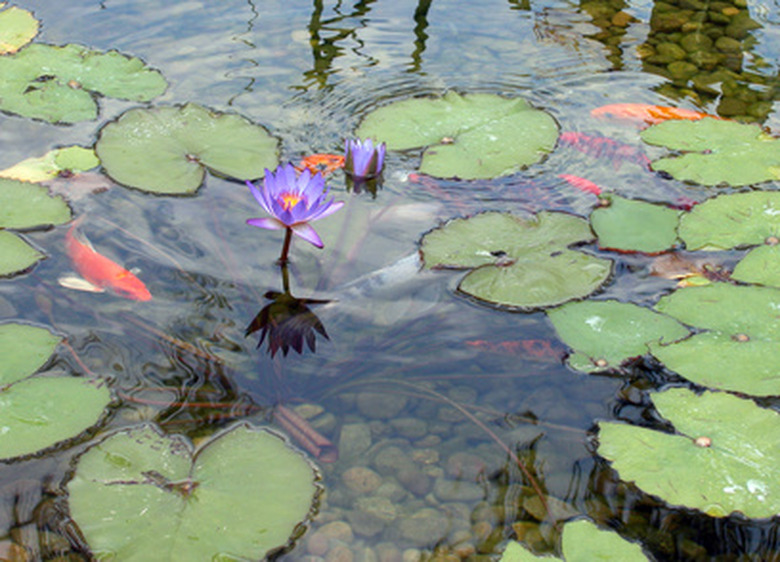How To Make A Homemade Pond Vacuum
Things Needed
- Pond pump
- Pump outlet/intake adapter
- Swimming pool cleaner extension pole
- Hand saw
- Drill
- PVC primer
- PVC glue
- 1 1/4-inch PVC female adapters, 2
- 1/2 inch long, 6-inch diameter PVC pipe
- 4 inch long, 6 inch diameter PVC pipe
- 1 1/4 inch PVC cap
- 3-inch-long 1 1/4 inch PVC connector
- 1 1/4-inch, 45-degree PVC electrical conduit
- Pool vacuum hose 1 1/4-inch diameter
- Pool vacuum leaf collector bag
- Measuring tape
- Felt tip pen
- Clamp
- 1-inch bolts, 2
- 1-inch washers, 2
- 1-inch nuts, 2
- Wrench
- Fine-grade sand paper
Tip
You can also make a pond vacuum using an old shop vac and a plastic barrel with a lid. The muck you collect in the pool cleaner bag can be used as compost for your plants, as it is decayed plant matter and fish waste. Pantyhose or a fine-mesh laundry bag can be used in lieu of a pool leaf collector. If you have trouble with the collector bag getting in the way as you vacuum, place a bit of Styrofoam in it to make a float.
Warning
You may wish to remove any animals living in the pond before you vacuum so as to not accidentally get them stuck in the vacuum's intake and harm them. Glue fumes are toxic. Always use glue in a well ventilated area.
Many people use fish ponds to house koi, goldfish and other aquatic life during the warm months of the year. In conjunction with having a water pump, a fish pond must also be periodically vacuumed, like a swimming pool. Tree leaves and other heavy sediment require a bit more suction than a regular pond pump can provide, and this is where a pond vacuum comes in handy. But you don't have to go out and purchase an expensive vacuum device. With the right tools, you can make one yourself.
Step 1
Measure 3 1/2 inches from the bottom of the short part of the curve on a 45-degree PVC electrical conduit and mark it with a felt-tipped pen. Cut downward from the mark with a hand saw to remove a 1/4-inch shard from the conduit.
Step 2
Make a single cut down the length of the 1/2-long PVC pipe to split it. Apply PVC primer, then PVC glue to the inner part of the PVC pipe, according to the instructions on the glue's packaging. Stretch open the 1/2-inch long PVC pipe, slip it over one end of the 4-inch-long, 6-inch diameter PVC pipe to make a collar. Clamp the 1/2-inch PVC pipe onto the 6-inch PVC pipe and let the glue set.
Step 3
Take the shaved conduit piece and set the flat, cut edge onto the combined PVC pipes. The short end of the conduit's bottom should extend 1 inch past the bottom of the 4-inch PVC pipe. Hold it in place and measure 1/2 inch below the collar. While holding the conduit in place, measure 2 inches up from the bottom of the PVC pipe and mark a dot with a felt-tip pen. Measure 1 1/2 inches up from the bottom of the PVC pipe and make another dot under the first one. Drill a hole on each dot. The hole needs to go through both the conduit and PVC pipe. Place a bolt through each hole, then a washer, followed by a nut. Firmly tighten with a wrench.
Step 4
Take the 1 1/4-inch cap and place it beneath the bolts on the conduit, leaving plenty of space on the conduit between the bottom bolt and the top of the cap. The bottom of the cap should extend 3/10 inch past the bottom of the 4-inch PVC pipe. Trace along the top side of the cap where it touches the PVC pipe. Cut out the inner part of the traced half-circle using a drill fitted with a 1 1/4-inch circular drill bit.
Step 5
Sand down rough edges of drilled hole. Push the closed end of the cap 1/4 inch into the hole. Place PVC primer and glue onto the cap to glue it in place. Let the glue set.
Step 6
Drill three holes along top of the end of the cap, three along the center and three along the bottom. Try to angle the holes upward if you can. Then place the 3-inch, 1 1/4-inch PVC connector into the PVC cap. They will fit snugly together, so you do not have to glue them together.
Step 7
Take the pool hose and remove the cuffed ends with a hand saw. Attach the 1 1/4-inch PVC female adapter onto each end of the pool hose, then place one end of the hose into the connector that is attached to the PVC cap. Connect the other end of the hose to the pond pump.
Step 8
Take the pool pole and attach it to the end of the conduit. Measure from the conduit's end to the hole on the pole to attached to a pool-cleaning accessory, and measure the same length on the top part of the conduit angle. Mark the spot with a marker and drill a hole. Place a bolt through the conduit and the pole and attach a washer and wing nut to the other side to fasten securely in place.
Step 9
Place the end of the pool leaf bag over the top of the collar on the 4-inch PVC pipe. The leaf bag is the top of the vacuum, the PVC pipe fitted with the drilled cap is the part of the vacuum that you run along the bottom. To run the pond vacuum, turn pump on and place end of vacuum into the pond, moving it slowly across its bottom.
